"ARMENIA AETERNA" WAS PRESENTED AT THE INTERNATIONAL BOOK FAIR
On Wednesday, May 8, the impressive book "ARMENIA AETERNA", by Alex Nahabetian and Miguel Huguet, was presented in the Carlos Gorostiza room of the 48th Buenos Aires International Book Fair.
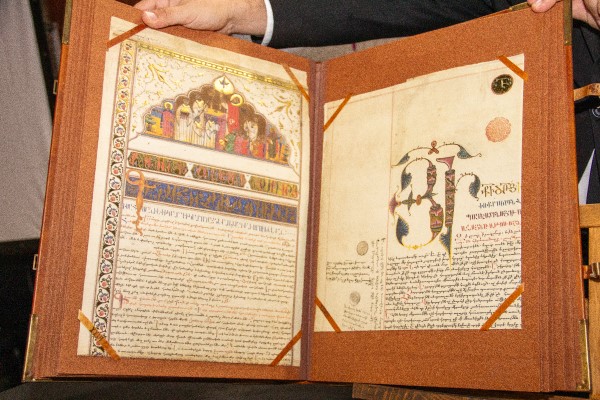
The authors, accompanied by Susana Dergarabetian, who collaborated on the project, spoke to a room full of guests and enthusiasts of Armenian history.
At the event, the presence of the Ambassador of the Republic of Armenia, Hovhannés Virabyan, Locum Tenens of the Armenian Apostolic Church for Argentina and Chile, Archimandrite Dr. Arén Shaheenian, stood out; the president of the Armenian Administrative Institution, Aram Karaguezian; the president of the General Armenian Union of Buenos Aires (UGAB), Antonio Sarafian; the honorary president of the AGBU, Rubén Kechichian; from the president of IARA Sergio Tchabrasian; the president of the Tekeyan Cultural Association, Sergio Nahabetian; and many members of the Armenian community in Argentina.
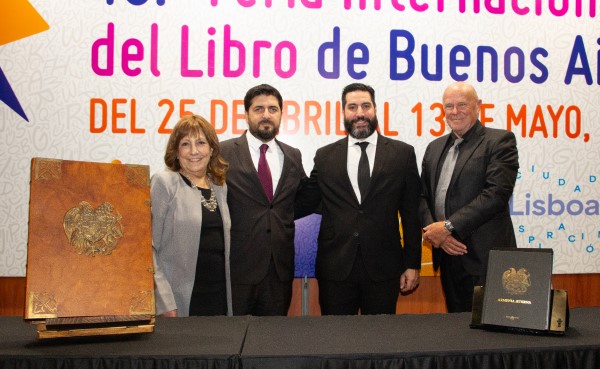 THE WORK
THE WORK
Susana Dergarabetian began the presentation by giving a breakdown of the content of Armenia Aeterna.
She explained that it is a compilation of 41 documents that traces the course of the origins and historical evolution of the Armenian people through archives from more than twenty countries in the world.
She then highlighted that “the original documents of the book were recovered from different archives and reproduced with innovative technologies along with artisanal processes that date back to the Middle Ages.”
More than 20 of these documents were exhibited in the Gorostiza Room and could be observed in detail by those present.
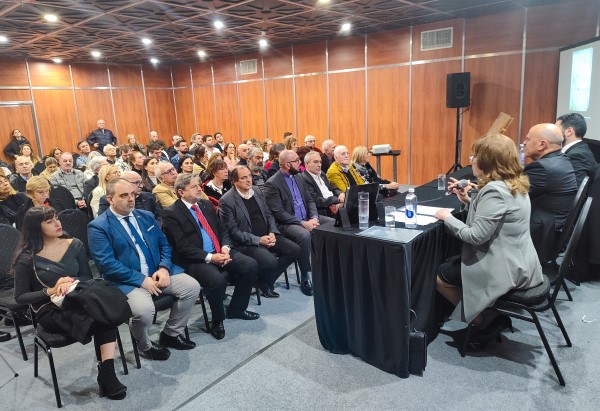 ABOUT THE AUTHORS
ABOUT THE AUTHORS
Subsequently, Susana Dergarabetian detailed the authors' careers.
Regarding Alex Nahabetian, he commented that he was born and raised in the Argentine Republic, within a traditional family from the Armenian community of Buenos Aires. He is currently a businessman and has resided in the State of Florida, in the United States, since 2005.
Of the author's origins, he said that "his 4 grandparents, whom he knew and enjoyed, came from refugee families in Argentina. He was educated in an environment of close proximity to the Armenian Apostolic Church, culture and community life in the that volunteer work, the vocation of service, helping the growth and maintenance of diaspora institutions were the parameters to follow.
Then, Dergarabetian spoke about the other author of this work, Miguel Huguet and commented that he is an economist and businessman; professor at the Autonomous University of Barcelona and who comes from the biotechnology sector where he worked for several years.
"Huguet is a passionate bibliophile, he has promoted editorial projects for the reproduction of documents and manuscripts, such as Andorra Aeterna or Cathalonia Aeterna," Dergarabetiedad expressed to the audience present.
"He has made his bibliophilia his passion, abandoning his professional activity in the field of 'molecules' (for 25 years he developed his career in companies in the biotechnology industry) to dedicate himself to the facsimile reproduction of illuminated manuscripts, and documents prior to Gutenberg. Over the years, he acquired a large and exclusive collection of illuminated manuscripts as a result of his tireless search around the world," he noted.
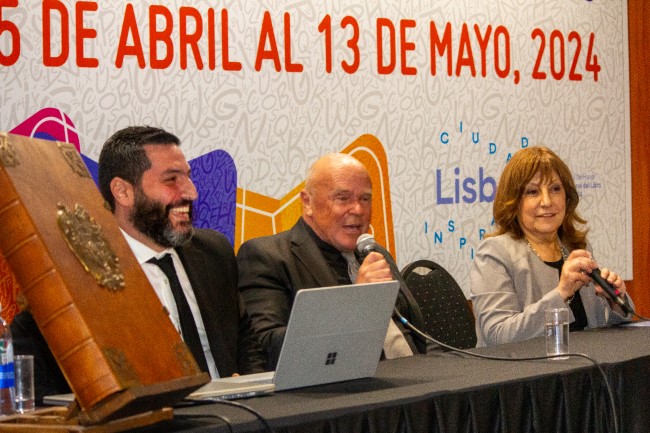 "TESTIMONY OF OUR PASSAGE THROUGH THE WORLD"
"TESTIMONY OF OUR PASSAGE THROUGH THE WORLD"
Regarding her participation in this work, Susana Dergarabetian said: "When Alex and Miguel joined me in the project I felt very honored and excited to be part of something so valuable and eternal. As Armenians, the meaning of this work aimed to leave absolute testimony of our passage through the world".
"After more than 5 years of starting this project, Armenia Aeterna became a reminder of who we are. We know that our ancestral enemies have invested and invest a lot of money in academic chairs at prestigious universities promoting an alternative version of history. But here "There is the true one, the irrefutable one, the one that the Armenians did not write, the one that wrote history," she concluded.
HOW THE IDEA WAS BORN
Subsequently, Alex Nahabetian began his talk by telling the genesis of this project born "7 years ago, by a mutual friend who put us in contact with Miguel in Miami."
The author explained that, in that first meeting between them, their life experiences and work projects were told.
"The talk continued until Miguel told me about his previous projects, very similar to this one (Andorra Aeterna or Cathalonia Aeterna) and I was fascinated by the quality and everything it meant," he said.
The author recalled that "already at that moment I began to think about Armenian history and as an Armenian, with my chest inflated, I said to myself: Who has more history than us? and how good it would be to do something about Armenia."
Alex Nahabetian commented that that same night I couldn't sleep thinking about the possibility of performing Armenia Aeterna. The next day, he called Huguet again and "there I suggested doing this work that had never been done before. Miguel accepted and it was there that we laid the cornerstone of this project," he said.
When they got down to work, meetings and trips began to meet the companies that carried out tasks such as "the special aging that was carried out in Italy or the company that made the final part of the book, made entirely by hand and in an artisanal way." , in Spain," he noted.
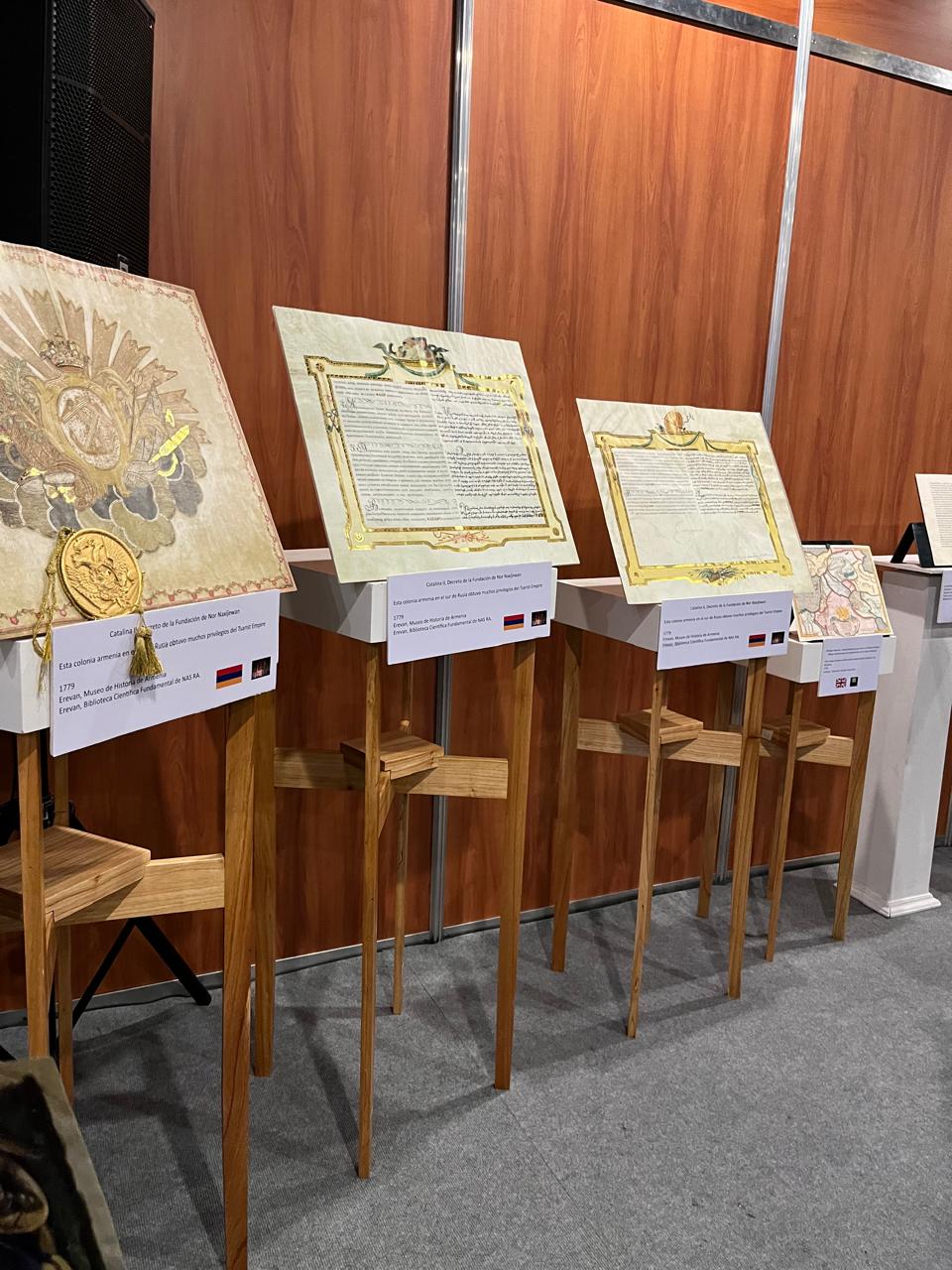 HISTORIANS
HISTORIANS
On the other hand, Nahabetian listed the specialists in Armenian history who collaborated in the production of this work: Professor Giusto Traina (Sorbonne Université) and Professor Aldo Ferrari (Ca' Foscari University of Venice). Both assisted by Dr. Immacolata Eramo (University of Bari 'Aldo Moro') and Dr. Paolo Luca (Ca' Foscari University of Venice).
"There were countless weeks and months of information exchange, trying to choose the most important essential documents for Armenian history" said the author and pointed out: "we managed to choose 41 documents that are the ones in this book that is accompanied by a book of study, where the details of each document are explained".
 The book contains documents in several languages such as classical Armenian, ancient Greek, French, medieval French, Latin, Russian and Ottoman Turkish.
The book contains documents in several languages such as classical Armenian, ancient Greek, French, medieval French, Latin, Russian and Ottoman Turkish.
"The first half are reproductions of manuscripts that illustrate the political evolution of the Armenian people. The second half are another 21 documents from different manuscripts, printed books and maps," Nahabetian said.
AROUND THE WORLD
A copy of this work was presented to SS Karekin II, Supreme Patriarch and Katolikos of All Armenians, to the current president of the Armenian Nation, Vahagn Jachaturyan, to the General Armenian Benevolent Union of Armenia, to Archbishop Hovnán Derderian, and soon, another will be delivered in Madenatarán.”
“Also, in Germany: it was presented at the Frankfurt International Book Fair; In Portugal it was given to the Gulbenkian Foundation, several presentations were made in the city of Los Angeles and in New York a copy was given to the headquarters of the General Armenian Benevolent Union. Now it was our turn to present it in Buenos Aires and particularly, it is a source of pride," he expressed.
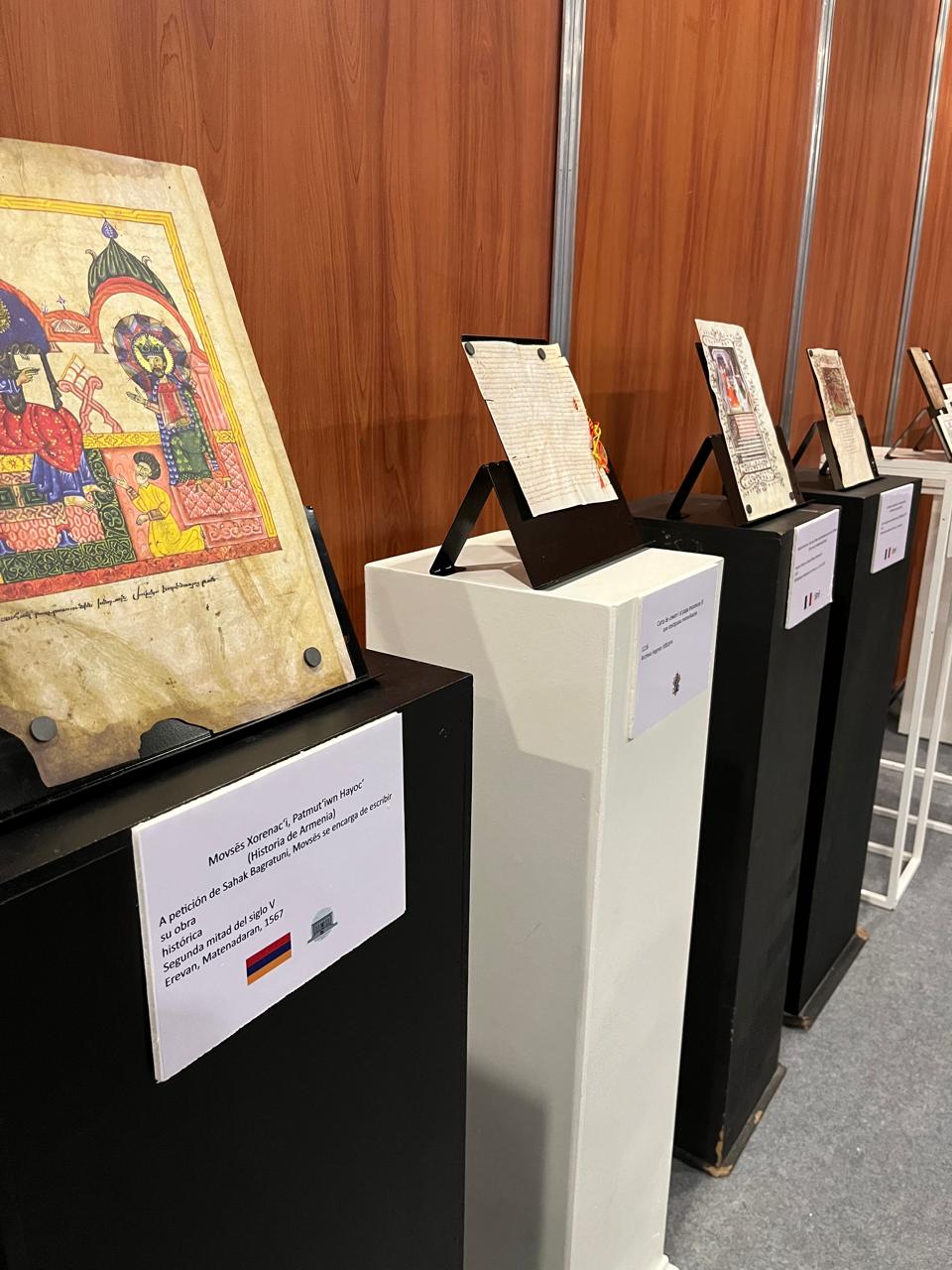 THE ARMENIAN INSTITUTIONS OF BUENOS AIRES
THE ARMENIAN INSTITUTIONS OF BUENOS AIRES
Regarding the presentation in his homeland, Nahabetian, highlighted that "this community (Buenos Aires) has very important and valuable institutions, educational, cultural, religious, sports, charitable, etc. And, honestly, in my 41 years I have not seen a similar community." "When one sees it from the outside it takes on a greater dimension of all the work of the leaders of all institutions. It is something incredible and I have seen it in very few communities," he concluded.
"BIBLIOPHILE"
The other author, Miguel Huguet, began his talk by talking about his passion for books and described himself as a "bibliophile."
"The bibliophile sector is very interesting but it was saturated with religious works, because it was the monks who wrote the history in the books," said Huguet.
"When Alex told me to do the same with Armenia, I asked myself: Armenia? Where is it? What is it?" he recalled.
ARMENIAN CIVILIZATION
"Armenia is a civilization. It is not just a town," said Huguet and recalled that "when we hired the most important historians in the world on Armenian history, we learned that they are few and you can count them on the fingers of one hand." .
"When you realize that the Armenian civilization was massacred by Parthians, Achaemenids, Mongols, by Ottomans. All civilizations that no longer exist, and you see that nevertheless, Armenia exists, with its paleography, its language... it has been exciting" concluded Miguel Huguet, visibly moved and earning the applause of the attendees.
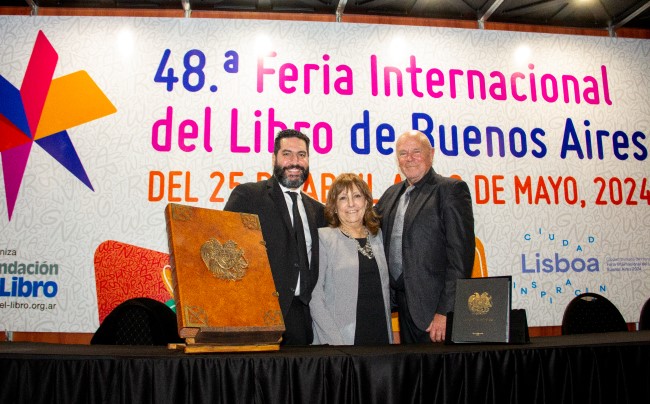 ARMENIAN HISTORY IN A UNIQUE WORK
ARMENIAN HISTORY IN A UNIQUE WORK
The editing is really impressive. Armenia Aeterna, is an essential book published by Encyclopaedia Mundi in four languages that contains unique capital documentation to understand the origins of Armenia.
The 41 documents in the book are presented in facsimile format and show the struggle of Armenians to survive, despite the constant attacks they have suffered and continue to suffer.
The result of this project is limited to a unique and unrepeatable edition of 991 copies numbered and authenticated by a notary of the European Union.
The project, promoted by Alex Nahabetian and Miquel Huguet, aimed to show the world the specific works kept in the Madenataran of Yerevan and in more than 20 archives in France, Italy, the Russian Federation, the United States, Israel, among others. countries.
The book was bound with lambskin, on board and parchment. The preparation and handling of the files was manual and the aging of the documents was carried out by hand.